Biofork GUERILU
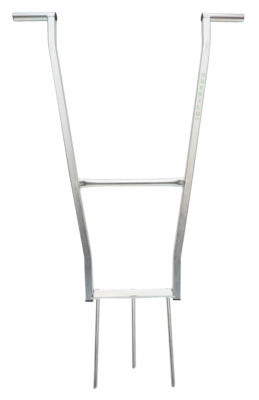
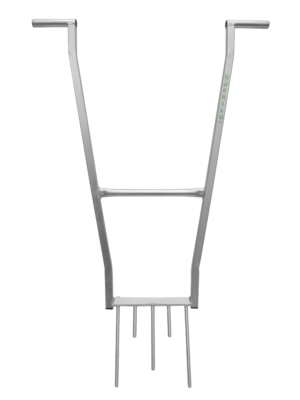
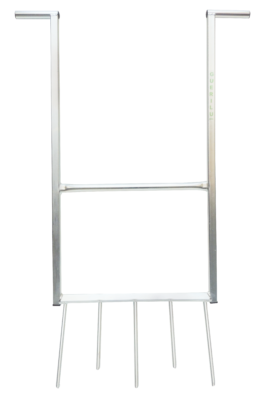
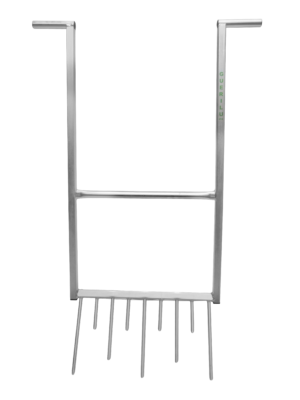
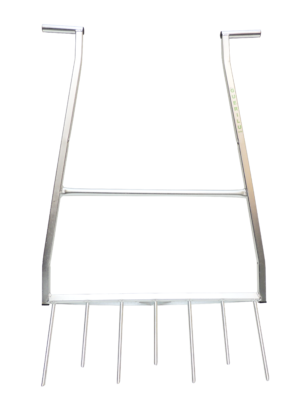
The GUERILU biofork is a tool designed to work the soil in depth without turning it over. Its ergonomic design makes the work efficient by reducing physical effort to a minimum. The GUERILU biofork is now available with 3, 5 or 7 tines.
1. What is a grelinette/biofork?
The name “grelinette” comes from its inventor, the Frenchman André Grelin (1906-1982). It was Olivier Grelin, his son, who started making grelinettes in their house in Arbin. He travelled all over France to sell them at organic fairs and events.
Today, the grelinette is also called a biobêche, bioculteur, ecological fork, biogrif, campagnole or aerofork. It is a tool that allows the soil to be aerated and loosened without turning it over.
The Guérilu biofork is composed of two galvanised steel handles, linked together by a metal crossbar in their lower part and a heel.
On this bar are fixed 3, 5 or 7 vertical, bevelled and sharp teeth, intended to be driven into the ground.
The Guérilu biofork has the enormous advantage of having a steel hoop welded to the back of the crossbar, which offers better support and makes it easier to lever.
We chose galvanised steel to prevent bits of paint from getting into the garden soil.
The Guérilu biofork is suitable for everyone. As the soil is not lifted, the back remains straight and perfectly preserved. You do not need to be in exceptional physical condition. However, remember that handling a 5-tine biohoe requires more effort than a 3-tine biohoe. Think about this when making your purchase!
2. How to choose between 3, 5 or 7 tines?
The Guerilu 7-tine grelinette is best suited to light soil, while 5-tine grelinettes are better suited to hard, sticky soil. For small flowerbeds, 3 tines are sufficient.
Even if the Guérilu grelinette seems heavy to carry, don’t worry: when using it, you only have to drag it, so it is easy to use, whatever your physical condition.
However, choose the number of tines according to the nature of the soil (heavy soil is more difficult to work with 7 tines), but also according to your strength: the more tines the Guérilu grelinette has, the more effort it requires to use.
3. Why use a grelinette?
The Guérilu or biobêche tine cultivator is used to decompact and loosen the soil, but also to facilitate the incorporation of fertiliser, to harvest tubers or to make holes for planting root vegetables.
Tillage is the first step on the way to a bountiful harvest. In order to respect the living beings in the soil, it is necessary to work the soil in moderation. When the gardener uses tools (whether manual, mechanical or thermal) to improve the porosity of his soil, he will inevitably destroy (momentarily) the ecosystem of beings living in it.
For land that has never been worked, an old meadow or land overgrown with wild grasses, it will probably be necessary to use a spade or a tiller. Beware, these should be avoided as much as possible. The tiller, by turning in the soil at high speed, makes the soil mealy, which reduces the aeration of the soil. This reduces the aeration of the soil, and soil-dwelling animals such as earthworms are cut to pieces.
If it is absolutely necessary to use the tiller, avoid using it in spring and autumn, when earthworms are most active. Finally, using a tiller can be hard on your body. It sends violent vibrations through your body. And it is not really environmentally friendly…
The use of a spade is also to be avoided. Using the grelinette can be up to 10 times faster than the classic spade, since the working width is greater and the tool more manageable. In addition, the position is much more comfortable as it does not strain your back. Secondly, when the soil is turned over, micro-organisms that cannot tolerate oxygen (anaerobic) are brought to the surface and those that need oxygen (aerobic) are suffocated. All these micro-organisms then die, which weakens the fertility of the soil!
Then, by digging, we bring the sterile soil to the surface, and humus should always be in the surface layers. This also brings up wild plant seeds that will germinate on the surface of your land. Finally, deeply turned soil, exposed to wind and sun, hardens and cracks, which you can avoid with your biogrif.
Why did our parents and/or grandparents use spades then? In the past, spades were a maximum of 20 cm high, whereas today’s commercial spades are 25 to 30 cm high. This deep spading is too aggressive for the soil.
Whether you are starting a new vegetable garden or maintaining it, don’t delay in using the Guérilu grelinette, before the weeds have invaded the ground too much. In fact, unlike digging, you can neither turn over the soil nor bury the plants to be eliminated.
As you can see, it is better to loosen the soil without turning it over. By aerating the soil, micro-organisms are kept in their original environment and the soil structure is preserved. Introducing oxygen into the soil allows the roots to expand and colonise the volume of soil needed for a good supply of water and mineral elements. It also allows the micro-organisms and animals living in the soil to breathe properly.
The GUERILU biofork allows effortless working of the soil in depth without turning it over. It stimulates the life of aerobic micro-organisms in the upper layers of the soil, the nutrients in the upper layer remain available for the plants and the seeds of unwanted plants remain buried in the depths.
4. When should the GUERILU grelinette be used?
When the soil is “in love”, that is, when it is neither too dry nor too wet.
Indeed, you should never work on soil that is too wet because if it is too wet, you risk doing more harm than good by compacting the blocks. In addition, the soil will stick to the tines, which makes handling more difficult.
On the other hand, in very dry soil, it will be difficult to push the tool in. The resistance of the soil may even overcome a cheap digging fork bought on Amazon. And it will be difficult to crumble the clods.
We therefore recommend that you use your Guérilu grelinette a few days after the rain, in just damp soil.
Finally, we recommend preparation in autumn for heavy clay soil. A light soil should be prepared at the end of winter or in early spring.
In autumn, you can make a light pass. This will allow water to infiltrate and air to penetrate the compacted soil. By breaking up any surface crust, you will break the waterproof layer that would cause water to run off. But you should not turn over the soil in the vegetable garden because this is when the rain comes back and the earthworms are most active. They help to digest the abundant organic matter in the soil to create soil fertility and stable humus.
In the spring, you return to the land when it has dried out a bit after the heavy winter rains. Aeration of the soil in the spring allows mineral elements to be brought up so that they can be quickly absorbed by the plants. They must be in sufficient quantity so as not to generate a growth failure due to lack of nitrogen. This is so that the plants have time to finish their growth cycle before a cold autumn which arrives quickly in some regions.
5. A Belgian-made grelinette?
If you order by mail order, the actual shipping costs to deliver a package of this size are between 15 and 20€. A cheap grelinette will certainly be an import. The steel standards of some countries are not necessarily as strict as ours. Ask the dealer about the country where the grelinette or aerofork is made.
If the grelinette is made by a craftsman, you can be sure that the quality is better. Otherwise, this person would have regular returns. This is regularly the case with some models sold in garden centres. But this is not a problem for them as it is a very small percentage of their overall turnover. It is difficult to find a quality grelinette on sale or in promotion.
